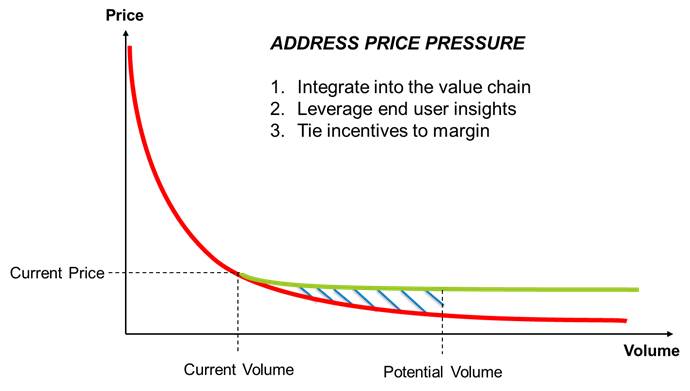Three ways manufacturers use sales strategy to address pricing pressure

There is no magic wand.
No matter how much you want to be a magician, waive a wand and make it disappear, price pressure remains one of the most irritating, profit-threatening challenges facing manufacturers. What can you do to address pricing pressure? The classic response to this question is innovate new products that offer greater differentiation. That’s fine, but innovation takes time, and that answer doesn’t provide any solace for the sales leader facing growing pricing pressure this month or quarter.
Counter Measures. As a sales leader, you can’t always change the products or the allotted resources, but you can change your sales strategy. Here are three examples of manufacturing companies that addressed price pressure head on – selling the same products and utilizing the same sales resources – by simply adjusting their sales strategy:
1. Integrate into the value chain. A manufacturer of a very basic, low-priced product focused sales efforts on establishing tight integration with some of its customers creating switching costs that reduce pricing pressure. In this segment of the market, the customer codifies vendor-specific part numbers in their supply system and makes repeat purchases. Multiply this by hundreds of different product models and part numbers and this manufacturer has created a switching cost in the form of time and hassle for the customer to update their purchasing system. Having reliably accurate and up to date information on parts and fulfillment times represents value to the customer. Switching costs can represent up to 1-2 percent of margin, giving the sales person on this account some cushion from the ordinary pricing pressure on these products.
The savvy salesperson who aptly articulates value to the customer beyond product features can create a decrease in price pressure. This example demonstrates that even businesses with commoditized products can find methods to reduce pricing pressure. Sales leaders can guide their teams to target customers where opportunity exists to tightly integrate into the supply chain. Sales leaders should be on the lookout to adjust coverage strategy in order to focus selling effort on sections of the market looking to consolidate vendors to better manage relationships and improve predictability. These actions will result in lower price pressure.
 2. Leverage end user insights. Another manufacturer sales team was dealing, not surprisingly, with the purchasing department of their customer, a large capital transportation manufacturer. Similar to many companies, purchasing aimed to reduce costs and forced the manufacturer’s sales team through never-ending rounds of bidding and presentations centered on price. To break the cycle, the sales team started speaking with some of the customer’s sales staff. They shared insights about the end user and how to better serve their needs. These insights led to some simple product fixes and process improvements. These adjustments enabled the vendor’s sales team to improve top-line performance by three percent in one quarter. In turn, the customer’s salespeople began recommending this manufacturer to their purchasing department. This led to preferred vendor status and decreased price pressure.
2. Leverage end user insights. Another manufacturer sales team was dealing, not surprisingly, with the purchasing department of their customer, a large capital transportation manufacturer. Similar to many companies, purchasing aimed to reduce costs and forced the manufacturer’s sales team through never-ending rounds of bidding and presentations centered on price. To break the cycle, the sales team started speaking with some of the customer’s sales staff. They shared insights about the end user and how to better serve their needs. These insights led to some simple product fixes and process improvements. These adjustments enabled the vendor’s sales team to improve top-line performance by three percent in one quarter. In turn, the customer’s salespeople began recommending this manufacturer to their purchasing department. This led to preferred vendor status and decreased price pressure.
Insights that drive better customer outcomes can give your sales team an advantage over the competition in the sales process and address pressures to discount price. Sales leaders can guide their teams to ensure they are influencing the influencers, and are not stuck in purchasing.
3. Tie sales incentives to margin. Increase sales rep accountability of margin by including it as the primary measure in their sales compensation plans. A large manufacturing company who faced a shrinking bottom line decided to focus on sales rep accountability. By adjusting the sales compensation plan to include margin as the main measure, the company achieved a 5 percent increase in Contribution Margin. After further analysis it was clear that the sales reps were spending up to 60 percent of their available selling time on products with the highest margin and/or lowest price pressure. Some sales people will tell you they cannot influence price. Don’t believe them. Good sales people are creative and resourceful. Incentives drive behaviors, and tying incentive dollars to margin in the right manner will foster stronger resilience to customer price pressure and direct sales effort toward high-margin products.
These three examples are all situations where companies applied sales strategy and effort to address price pressure. In all three cases, they were able to increase profitability without making changes to product features. In today’s manufacturing industry, product differentiation is fleeting. Manufacturers can enjoy significant product differentiation and the associated price premiums it affords while it lasts. But the sales force can play an important role in addressing pricing pressure as these stories illustrate. Manufacturers that apply these three methods in combination can realize 3-5 percent price improvement or greater.
How is your manufacturing sales force addressing price pressure? Does your sales leadership provide the needed guidance to target the right customers and arm your sales force with the right selling tools to combat price pressure?
Learn more about our Manufacturing practice, and contact us today.
Contributor: Mike White, Consultant in Alexander Group’s Chicago office.